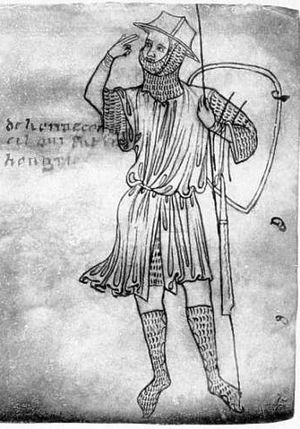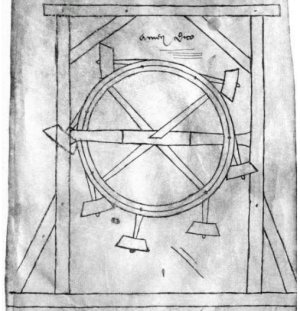Villard de Honnecourt facts for kids
Villard de Honnecourt was a skilled artist and engineer from France who lived in the 13th century. We know about him mainly because of a special book he left behind. This book is like a "sketchbook" or "portfolio" filled with about 250 drawings and designs of many different things. It gives us a peek into what people were interested in and how they worked during the Middle Ages.
Contents
Who was Villard de Honnecourt?
We don't know much about Villard's life, except for what his sketchbook tells us. Because his book has so many drawings of buildings, people used to think he was a traveling architect and engineer. An architect designs buildings, and an engineer designs machines and structures.
Villard created a kind of instruction manual with his drawings. It showed how to make different objects and included notes on buildings he had seen. His work combined old ideas about geometry with the building methods of his time. This helped spread the style of Gothic architecture across Europe. He traveled to important building sites, like the Laon Cathedral and Rheims Cathedral, to draw their details.
Villard proudly wrote that he had been to "many lands." He even mentioned a trip to Hungary, where he stayed for "many days." We don't know why he went there, but some people think he might have been sent to get a special item called a relic related to St. Elizabeth of Hungary. He also said he drew many things "from life," which was unusual for artists of his time and became more common much later during the Renaissance.
What is Villard's Sketchbook?
Villard de Honnecourt's famous "sketchbook" or "manual" was made between about 1225 and 1235. It was found in the mid-1800s and is now kept in a library in Paris, France.
The book has 33 sheets of parchment, which is like a very old type of paper made from animal skin. Each sheet is about 23.5 by 15.5 centimeters (9.25 by 6.1 inches). The book is not complete, so we don't know how big it was originally. The drawings and notes are placed in many different directions, which makes it seem like the pages were not originally meant to be put together as a book. It's a mystery whether Villard himself or someone else later put the pages into a book.
What kind of drawings are in the book?
The album contains about 250 drawings. These include:
- Building designs: Plans, elevations (how a building looks from the outside), and small details, often of real buildings.
- People and animals: Many different human and animal figures.
- Sculptures: Groups of religious and everyday figures that might have been ideas for statues.
- Church items: Objects used in churches.
- Machines: Mechanical devices, like a perpetual-motion machine (a machine that keeps moving forever without any energy source, which is impossible in real life!).
- Engineering tools: Lifting devices and a saw powered by water.
- Automata: Early forms of robots or moving figures.
- War machines: Designs for things like a trebuchet (a large machine used to throw rocks in battles).
- Many other subjects.
Many drawings also have notes and labels written next to them.
What was the sketchbook for?
People have different ideas about why Villard made this album. At first, many thought it was a training manual for architects. However, some researchers today disagree. They think Villard's drawings might be too simple for that. But others argue that the drawings were made simple on purpose, to help architects remember important ideas they learned by word of mouth.
See also
In Spanish: Villard de Honnecourt para niños



